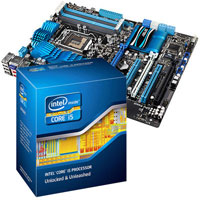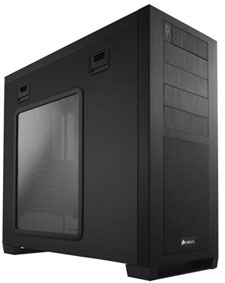Sandy Bridge Buyer’s Guide
by Zach Throckmorton on June 17, 2011 3:20 PM ESTWhat Can You Build for $2000?
There’s certainly a case of diminishing returns as you go up the price ladder. Our budget system checks in at under $500, our midrange build goes for less than $1000, and now we’re moving all the way up to $2000. There are areas where this system will be close to twice as fast as the midrange build, but that’s mostly in games and comes courtesy of the graphics card(s). If you’re looking for all that gaming performance without dropping two grand, take the midrange build and add the GPU(s) and power supply from the list below—you’ll get 85% of the CPU performance and 99% of the gaming performance for under $1400. But there are other benefits to be had; here’s the full list of parts.
| High-End Core i7-2600K System | |||
| Part | Description | Price | Rebate |
| Processor | Intel Core i7-2600K Sandy Bridge | $313 | |
| Motherboard | ASUS P8Z68-V PRO LGA 1155 | $205 | |
| Memory | Patriot Gamer 2 Series 8GB (2x4GB) PGD38G1600ELK | $85 | -$15 |
| Graphics | EVGA 015-P3-1580-AR GeForce GTX 580 1536MB GDDR5 | $470 | -$30 |
| Primary Storage | Intel 510 Series 120GB SSD | $280 | |
| Secondary Storage | Samsung SpinPoint F3 HD103SJ 1TB HDD | $60 | |
| Optical | LITE-ON iHAS124-04 DVD Burner | $25 | |
| Power Supply | Corsair Professional Series AX750 750W PSU | $170 | -$20 |
| Case | Corsair Obsidian Series 650D | $200 | -$20 |
| CPU Heatsink | Cooler Master Hyper 212 Plus RR-B10-212P-G1 CPU cooler | $27 | |
| OS | Microsoft Windows 7 Home Premium 64-bit | $100 | |
| System Total | $1935 | $1850 | |
If the Core i5-2500K is so amazingly capable, then why spend almost $100 more on the Core i7-2600K? On the surface, it’s only clocked 100MHz higher at stock, can only turbo 100MHz higher, has only 2MB more L3 cache, and doesn’t have more cores. However, it does have Hyper-Threading, so if you use multithreaded applications—like many video encoding, rendering, and compression applications—you’ll definitely benefit from going from the Core i5-2500K to the Core i7-2600K. For the more typical office and Internet applications, though, the performance difference is negligible. One other thing to note is power consumption—the Core i7 pulls ever so slightly more electricity than the Core i5. That is, even though the i7 is much more capable at certain tasks than the i5, it doesn’t use more juice. You can get a good idea of how the two chips compare, and whether what you do benefits from Hyper-Threading, by looking at our Bench results.
 We’ve paired the Core i7-2600K with the ASUS P8Z68-V PRO that we recently reviewed. It sports a plethora of ports along with headers for case front USB 3.0 ports—in addition to the usual front USB 2.0 and Firewire ports. , Like many other high-end Z68 motherboards, the P8Z68 also supports SLI and CrossFire, so whether you choose the AMD or NVIDIA graphics route, the board has you covered for dual-GPUs. However, that doesn’t mean we have to start with two graphics cards, which brings us to the graphics configuration.
We’ve paired the Core i7-2600K with the ASUS P8Z68-V PRO that we recently reviewed. It sports a plethora of ports along with headers for case front USB 3.0 ports—in addition to the usual front USB 2.0 and Firewire ports. , Like many other high-end Z68 motherboards, the P8Z68 also supports SLI and CrossFire, so whether you choose the AMD or NVIDIA graphics route, the board has you covered for dual-GPUs. However, that doesn’t mean we have to start with two graphics cards, which brings us to the graphics configuration.
In speaking with our resident graphics expert, we came to the agreement that the best overall experience will be had by sticking with a single GPU—at least until you max out that component. You won’t have to deal with CrossFire or SLI headaches, driver updates (and game profiles) become less of a hassle, and everything just works as expected. As such, we’re recommending NVIDIA’s GeForce GTX 580 for our high-end setup, currently available with rebates starting at $440. Just to be clear, for a similar price you can actually get better performance by going with dual GPUs, but CF/SLI scaling is never perfect and occasionally has issues with new releases that might take a couple months to get worked out.
If you’d still rather go with CF/SLI, you can pick up a pair of Radeon HD 6950 2GB cards for $460 (after $40 MIR), or you can cut costs even further by grabbing a pair of GTX 560 Ti cards in SLI for $400 (after $60 MIR). You can see how the single GPUs compare in our GTX 560 Ti review, and CF/SLI scaling is generally similar as you can see in our HD 6990 review. The performance edge tends to be in favor of 6950CF, and the 2GB 6950 cards will also have an edge at 2560x1440/2560x1600 and higher resolutions—and really you should have at least a 27” WQHD panel if you’re looking at this sort of graphics setup. But going back to our primary recommendation, the GTX 580 performs nearly as well in current games, it won’t have any CF/SLI idiosyncrasies, and if you’re really looking for a high-powered gaming setup you can always add a second 580 later.
For storage, we’ve gone the SSD+HDD route once more, only with a higher capacity, higher performance, and higher quality Intel 510 SSD this time. We’ve kept the same 1TB HDD for mass storage, but you can always go with a 2TB drive (or additional HDDs) if you need more capacity. We discussed the SSD particulars with Anand before settling on the Intel 510, and again there are some viable alternatives. If you’re after the absolute fastest 120GB SSD, OCZ’s Vertex 3 IOPS MAX is what you’ll want, but retail pricing currently starts at $310 shipped. For $30 less, Intel’s 510 120GB may not be quite as fast, but Intel’s reliability track record is definitely better than SandForce based SSDs. Realistically, outside of extremely taxing storage workloads—workloads most home users will never actually run—any of the latest generation of SSDs will be plenty fast. If the IOPS MAX is the most expensive 120GB, the OCZ Agility 3 120GB is on the other end of the spectrum and comes with a downright affordable price of $200 (after $30 MIR) by comparison. Worst-case performance (i.e. reading uncompressible data) takes a pretty big hit, but otherwise the Agility 3 and Vertex 3 120GB SSDs are very comparable and you save $60 compared to the Vertex 3. You’re still taking more of a risk with SF controllers, but as far as performance goes the SF-2200 drives are the current performance king.
Rounding things out, Patriot offers a solid 2x4GB kit of DDR3-1600 that overclocks well, is in my experience reliable, and has unobtrusive heatspreaders that go well with the ASUS motherboard’s color scheme. Corsair’s Professional Series AX750 outputs 750W at 80 Plus Gold efficiency and it’s fully modular. It’s about as high-quality as a PSU gets for a reasonable price. This PSU provides clean, stable power  to this gaming-oriented beast of a computer, with room to spare for two GPUs and a heavily overclocked CPU. (If you do plan on adding a second GTX 580, though, make note that we’ve hit 850W under load using an SLI 580 setup, so you’ll likely need to move into the kilowatt range.)
to this gaming-oriented beast of a computer, with room to spare for two GPUs and a heavily overclocked CPU. (If you do plan on adding a second GTX 580, though, make note that we’ve hit 850W under load using an SLI 580 setup, so you’ll likely need to move into the kilowatt range.)
Housing all of these impressive components is the Corsair Obsidian Series 650D. This case has ample room for a CrossFire or SLI setup, as well as great air-cooling for the heat generated by the CPU and GPU(s) during marathon gaming sessions. It’s also very water-cooling friendly, if you decide to go that route. While I’m not usually a fan of windowed cases, this system is simply too awesome to hide away the internals. We’re coming in slightly under budget for a change, especially if you factor in rebates, which leave us room for a decent midrange aftermarket CPU cooler. The stalwart Cooler Master Hyper 212+ isn’t the best CPU HSF on the market, but it’s quiet, effective, and reasonably priced—and it should let you approach a 5GHz overclock on the Core i7-2600K.
The final tally comes to just $1850 after rebates, which means if you’re still looking for other ways to waste spend your money, you could opt for a higher capacity SSD, add in Blu-ray support, toss in a larger HDD, or look for better cooling. We’re very impressed for just how much you can get for ‘only’ $1850, though, and no one would be unhappy running such a system right now.










90 Comments
View All Comments
gregounech - Friday, June 17, 2011 - link
FIRST YAY.DigitalFreak - Friday, June 17, 2011 - link
Morondavegraham - Friday, June 17, 2011 - link
is something missing here?meth0s - Friday, June 17, 2011 - link
Maybe this went up a bit early ;-)ImSpartacus - Friday, June 17, 2011 - link
Hey, I'll give you props for trying. Can't get it right every time.ImSpartacus - Friday, June 17, 2011 - link
Oh, I get it. This is the blip for RSS feeds.Can't wait for the rest of it!
JarredWalton - Friday, June 17, 2011 - link
Whoa! Not sure what happened there, but I was still editing the article and putting it into the CMS when you guys started looking at it. LOL. It's now finished so read at your leisure.davegraham - Friday, June 17, 2011 - link
lol...no prob, Jarred.Zink - Friday, June 17, 2011 - link
You should scale the cases so readers can see how much bigger than a 300 the 800D is.marc1000 - Friday, June 17, 2011 - link
yes, the size of the case is important too. I quit buyn a HAF912 because it won't fit in my desk. I will have to change the desk first! :(